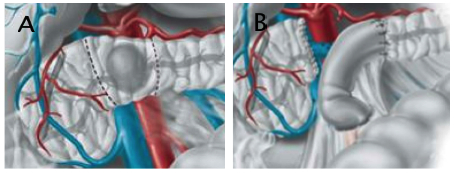Middle segment pancreatectomy
Middle segment pancreatectomy consists of a limited resection of the midportion of the pancreas. This procedure allows a surgeon to preserve pancreatic parenchyma and consequently long-term endocrine and exocrine pancreatic function. Indications to middle segment pancreatectomy include benign and borderline neoplasms of the pancreatic body.
After identification and isolation of major vascular structures around the pancreatic body and neck, the segment of the pancreas with the tumor is transected to the left and to the right of the lesion (Figure 1A). The cephalic stump is sutured with interrupted stitches after elective ligation of the Wirsung’s duct or by means of a stapler.
The reconstruction phase involves one or two anastomoses:
- Pancreatic anastomosis. The pancreatic distal remnant is anastomosed to a jejunal Roux-en-Y loop (pancreatico-jejunostomy, Figure 1B) or to the posterior wall of the stomach (pancreatico-gastrostomy).
- Enteric anastomosis. After pancreatic-jejunostomy, the Roux loop is connected to the distal jejunum. .














